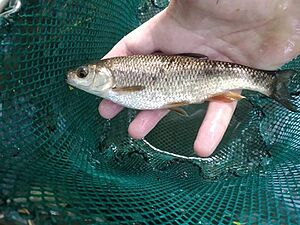Squalius keadicus facts for kids
Quick facts for kids Squalius keadicus |
|
|---|---|
 |
|
| Conservation status | |
| Scientific classification | |
| Synonyms | |
|
Leuciscus (Telestes) souffia ssp. keadicus Stephanidis, 1971 |
Squalius keadicus is a species of fresh-water fish in the family Cyprinidae. It is found only in Greece, and known as the menida in Greek.
It is endemic to the Evrotas drainage and the Vassilopotamos stream in the southern Peloponnese.
Contents
Taxonomy
Phylogenetic studies on Leuciscinae provide evidence about the uniqueness of S. keadicus as an element of the ancient ichthyofauna and one of the most ancestral Leuciscus s. l. taxa of Greece, and perhaps of Europe.
Description
Body laterally compressed with dark brownish-blue colouration. D III/8, A III/8–9 (10), C 19, P I/13–15, V/II 7–9, Ll. 44–51, L. transverse 9–10/3–4, gill rakers 7–9, vertebrae 38–42, mouth subterminal. Maximum body length: the species grows up to 25 cm (9.8 in) TL, but more recently the longest specimen found had 15 cm (5.9 in) SL. Sexual dimorphism: males are smaller in size and with rather bigger pectoral and pelvic fins than females.
Habitat
According to Crivelli, S. keadicus prefers habitats with slow current. Barbieri et al however reported the species as energetic and strongly rheophilic, living in open sites of the river, on stony bottoms with a fast flow and relatively cool water. It feeds throughout the water column, principally on aquatic insects. The strongly rheophilic behaviour confines the species to river sections of increased flow, an area which is estimated to be far less than 10 km2 (3.9 sq mi).
Reproduction
It matures in the second year of life (males possibly mature in the first). The breeding season is generally restricted in mid-spring. The species produces adhesive yellowish eggs, about 2 mm (0.079 in) in diameter from which unpigmented embryos, about 5.1 mm (0.20 in) TL, hatch out.
Conservation
It is threatened by habitat loss. The major threat is summer drought and concomitant water over-abstraction that lead to habitat degradation and loss. In the last decade, all tributaries and a large portion of the river dry up completely during summer. In addition, pollution from the local agricultural industries degrades water quality, especially during dry periods, leading to sudden mass mortalities. One of the possible consequences of the population decline is the reduction of the species’ genetic diversity that imposes a serious threat per se, as it lowers its ability to cope with adverse environmental changes. In the past, S. keadicus was abundant along its entire distribution area. In recent years, the population size in Evrotas has dramatically reduced. Moreover, the Vassilopotamos population is possibly extinct. It is protected by Presidential Decree No. 67/1981 of the Greek State.


